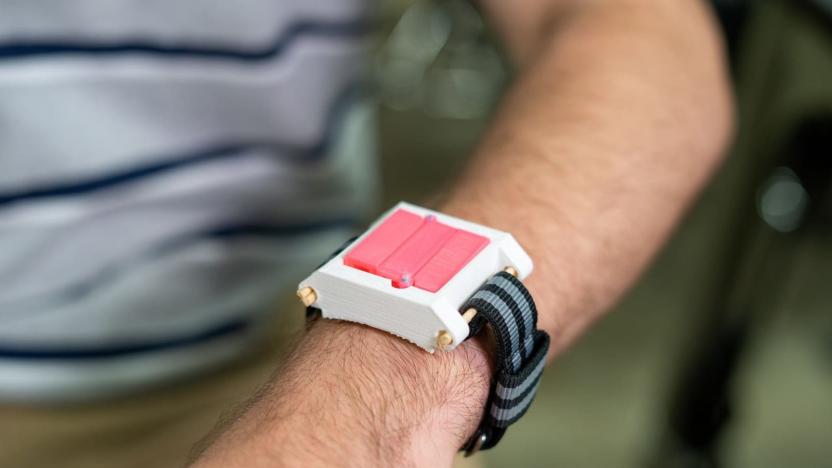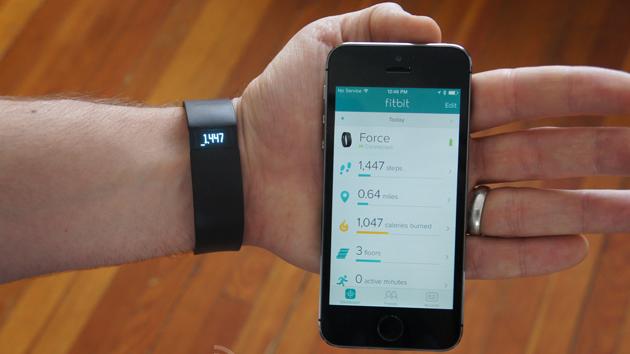allergies
Latest

Syringe 'watch' puts a life-saving allergy shot on your wrist
If you're prone to serious allergic reactions, carrying an epinephrine shot (such as an EpiPen) could be vital. Those shots are often bulky, though, and there's a real chance you could lose yours right before you need it. Students at Rice University have a (relatively) simple solution: put the shot on your wrist. They've developed a wearable, the EpiWear, that hides a foldable epinephrine syringe in a device not much larger than a watch. If you're in an emergency, you just need to unfold it, flick a safety lever and push a button when you're ready to inject the medicine into your thigh.

Google adds allergy forecast info to mobile search results
One antihistamine or two? Google is making sure hay fever sufferers can answer that question in double quick time, thanks to the new addition of pollen measurements in search results. Plug an allergy- or pollen-related query into your Android smartphone and search results will now include a simple breakdown of current and predicted pollen levels. The new type of rich card result is populated by data from The Weather Channel, and as always, you can get more detailed info by tapping on the card itself.

ICYMI: Salamander bot and allergy cells: Good for something
try{document.getElementById("aol-cms-player-1").style.display="none";}catch(e){}Today on In Case You Missed It: A robotic salamander was invented by the EPFL and has a true to life spinal cord. Also researchers at the University of Virginia School of Medicine found that immune cells that normally create an over-reaction in some people, resulting in allergies or asthma, may also protect people against a certain kind of fatal infection. Finally, University of Buffalo researchers are making their own lava, you know, for science. As always, please share any interesting tech or science videos you find by using the #ICYMI hashtag on Twitter for @mskerryd.

Tesla puts its extreme air pollution filter to the test
When Tesla revealed that the Model X (and eventually, the Model S) would have a HEPA filter so effective that it could protect against bioweapons, people were understandably skeptical. Can it really save you from terrorists? Apparently, it just might. Tesla has revealed some of the in-house testing it conducted for the filter's Bioweapon Defense Mode, and its ability to clean the air borders on overkill. The electric car maker put a Model X into a bubble with extremely dangerous air quality levels (83 times dirtier than the EPA's "good" rating) and watched as the filtration system rendered the air so clean that sensors couldn't even detect what pollution was left. You could drive through a "military grade" attack and not even notice, Tesla claims.

Smart purifier tells you what's in the air
With certain exceptions, air purifiers aren't especially smart or powerful. They'll remove some of the nastiness, but it's anyone's guess as to how much there actually is. Sprimo thinks it can change that: it's crowdfunding a purifier that's not only more effective than conventional rivals (reportedly up to 50 times more efficient), but designed from the ground up with intelligence in mind. It'll tell you the basic contents of the air and give you a quality rating to give you a sense how clean that air really is. The device will also give you a sense of what filters to use (say, one geared towards pollen) and tell you when you're likely to need a replacement.

Wearable craze adds skin sensitivity to the list of considerations for gadget buyers
We were quite impressed with Jawbone Up24 when we reviewed it. But, a few weeks later, things soured a bit when an editor developed a rather unpleasant rash from the device. Turns out it's not all that uncommon a reaction. While the usual list of concerns for gadget buyers focuses on specs, features and in certain cases portability, with the advent of the wearable, consumers need to start worrying about their own skin sensitivity as well. Are you particularly susceptible to bacterial infections? Are you allergic to nickel or latex? Then that's something that you'll have to take into consideration when it comes time to pick out a fitness tracker or smartwatch. In addition to our anecdotal experience, we've heard similar complaints about past versions of the FuelBand and the Engadget forums are alive with reports of sores and rashes associated with the Fitbit Force. While a sensitivity to nickel would be the most immediate suspect in cases like these, according to dermatologist J. Todd Williams, M.D., it appears something else is to blame. The Force does contain trace amounts of the metal in the surgical-grade stainless steel used on its body, but the position of the rashes would seem to rule out it out in many cases. The same would be true of Up users, as only the cap emblazoned with the Jawbone logo contains nickel plating. And since the Up is coated in a hypoallergenic rubber and the Force forgoes latex as well, it seems an allergy to that particular polymer isn't the culprit either.

WRUP: Achoo! edition
How's those allergies treating you? Here in lovely Washington, DC, the cherry trees blossomed for an entire half hour or so before impending storms threatened to whip away every flower. In the meantime, though, allergies are thick enough that I'm pretty sure the Sha of Allergies is lurking around the corner. Our bonus question this week: How do you feel about the pace of the expansion so far? It seems to be going pretty well, and it feels right. I mean, dailies, blah blah, but the content patches seem pretty swift.

NutriSmart prototype embeds RFID tags directly within food, traces your lunch from start to finish (video)
RFID tags are already used to trace everything from poker chips to hotel towels, but what if these little pellets were embedded directly within your lunch, providing everything you'd ever wanna know about that ham sandwich you're about to beast? That's the idea behind NutriSmart -- a food tracking system that revolves around edible RFID tags. Developed by Hannes Harms, a design engineering student at the Royal College of Art in London, these little markers would allow consumers to trace the entire supply chain behind every item in their cupboard, while feeding valuable nutritional information to dieters or people with particularly dangerous food allergies. Kodak, as you may recall, came up with a similar idea a few years ago, though Harms' prototype extends beyond the realm of medical monitoring. Properly equipped refrigerators, for example, would be able to alert users whenever their stock's about to expire, simply by scanning the tags. The NutriSmart concept also calls for a smart plate, which Harms describes as an "invisible diet management system." Just put your meal on the plate and an embedded reader will analyze your grub, tell you how many miles it traveled before arriving at your kitchen and transmit all of its history and caloric data to your phone, via Bluetooth. No word yet on what would happen to these tags post-digestion, though our inner 13-year-olds are giggling at the possibilities. Video after the break.

Pollen-sniffing robots put on duty in Japan
In yet another example of robots getting the short end of stick, a Japanese weather forecasting company is set to deploy a swarm of some 200 pollen-sniffing robots throughout the country, which will warn us humans of any impeding pollen-related dangers (and no doubt scare a few unsuspecting animals in the process). As you can see, the robots are of the spherical variety, and measure a scant one foot across and weigh in at about 2.2 pounds. Sticking true to creepy robot conventions, they also boast glowing eyes, which light up in one of five different colors to indicate the level of pollen in the air. Somewhat curiously, that information takes a rather roundabout way back to the company's headquarters, with 200 allergy suffers volunteering to keep watch on the robots and rely their status back to the company.

Thanko's USB Mask circulates air, freaks out co-workers
Nah, USB-powered fans aren't anything special these days, but infusing a couple of 'em into a bizarre facial mask and marketing it to folks with allergies earns top marks in the outlandish department. Thanko, the folks who continually put the fun back into USB, is busting out yet another oddity that relies entirely on USB power and your willingness to suffer through public humiliation. The whirlwind mask purportedly circulates airs and filters the incoming flow in order to provide a constant stream of clean, "purified" air, which could actually be useful for secretaries or other cube-dwellers who are forced to inhale the same stale office air day after day. So if you've been having trouble breathing, and don't mind being tethered to your computer nor the constant whirring that'll surround your mouth, you can snag the USB Mask now for ¥2,480 ($21).[Via Engadget Japanese]






